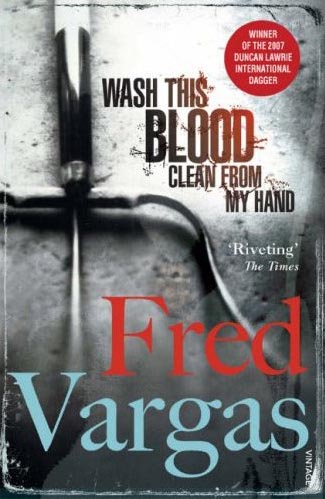
EURO CRIME
Reviews

Vargas, Fred - 'Wash This Blood Clean From My Hand' (translated by Sian Reynolds)
Paperback: 400 pages (Jan. 2008) Publisher: Vintage ISBN: 0099488965
The eccentric Commissaire Adamsberg and his team, with varying degrees of reluctance, are going to Canada to learn about DNA fingerprinting techniques from none other than the famed Mounties. Before leaving, however, Adamsberg learns of a death that strikes him with dread, for the victim has been killed by what appears to be a home-made trident, a method identical to that used by Adamsberg's bete noir, a serial killer called Judge Fulgence, who has been dead for more than ten years. How can a ghost have committed a murder? If you can't live with a trident as a murder weapon, you probably shouldn't read on, as there is much to follow that is even more bizarre.
Adamsberg had grown up in the same village as the judge. When he was a teenager, a young girl was killed, her death blamed on her boyfriend, Adamsberg's younger brother Raphael. Accused of the crime, Raphael managed to disappear before being convicted (partly helped by his brother), but Adamsberg became convinced that the judge was to blame and has (we are now told) spent a large part of his subsequent career trying and failing to convict the evil judge. The judge's network of contacts not only kept him safe from the law but, Adamsberg is convinced, framed other people for the crimes and, through blackmail, kept those people silent about the truth.
The new murder brings all this history to light. Adamsberg manages to alienate the local police investigating the crime by his insistence that the evil but dead judge is to blame. At this point, he and his team leave for Montreal and Adamsberg has to put his doubts on hold. The Montreal sequence of the novel is full of nice observational touches of culture clashes and character sketches, with an academic twist. Here is Adamsberg trying to distract his colleague Danglard from his terror of flying by persuading him to watch the plane's TV channel:
"There's a documentary about the precursors of the Italian Renaissance. That's for you, isn't it? The Italian Renaissance?"
"Already know all that stuff”, muttered Danglard, his expression fixed, his fingers still gripping the armrests.
"Even the precursors?"
"Know all that too."
In Canada, on one of his regular walks by the river, Adamsberg meets the Frenchwoman Noella, a rather unhinged person who has taken to hanging about there while she works to pay for her flight home after being abandoned by her lover. She drags a reluctant Adamsberg into an affair: even though Adamsberg doesn't seem to like or be attracted to Noella, he acts out of jealousy after jumping to conclusions when glimpsing Camille, a previous lover - who in one of rather too many coincidences that pepper this book, happens to be in the country playing in a string quintet.
When the course is over, the team returns to Paris, where Adamsberg becomes increasingly alienated because of his conviction that the judge is still alive and is continuing his killing spree. Then he is told to return to Canada with an unlikeable colleague, Lieutenant Retancourt, to help the Mounties with an investigation. When Adamsberg arrives, he finds himself accused of murder - of someone who has been killed in just the same way as one of the judge's victims. This is the part of the book in which Adamsberg is least sympathetic as a character, as all his efforts and thoughts are focused on himself and of his escape, and none at all for the victim, who he treats very callously. The character of Retancourt provides some welcome thrills and offbeat humour, but for me this whole episode is tainted by this coldness in which the victim is ignored and unmourned, it seems by everyone. In another unlikely coincidence, Adamsberg discovers that his long-lost brother Raphael is living in North America.
Adamsberg spends most of the rest of the book as a fugitive hiding out at the flat of old, loyal Clementine (a character from the previous book), with plenty of time to think. It isn't too hard for the reader to work out the basic outline of how and why Adamsberg has been put in this predicament: the pleasures of this book are not the rather weak mystery elements, rather they are the many charmingly eccentric aspects of a story which eventually unfold into Adamsberg's full realisation of how the crimes had been committed, and a final vindication.
There are far too many convenient coincidences: the reappearance of Raphael, Retancourt's ubiquitously helpful friend who can fake passports, the brilliant hacking talents of Clementine's ancient lodger who mysteriously manages to find out the answer to any question asked of her by a few hours on the internet, and other assorted conveniences. Look too close and the whole construct - a judge who can "die" and who over many years forces various doctors, lawyers and others to abet his crimes - is frankly risible. However, Vargas is such a charming writer that one can suspend belief and be carried along by her alternative universe, her telling observations of character and culture, and admire the house of mirrors she creates in this amusing and absorbing, yet cold, tale.
Read more reviews of WASH THIS BLOOD CLEAN FROM MY HAND here, here and here.
Maxine Clarke, England
February 2008